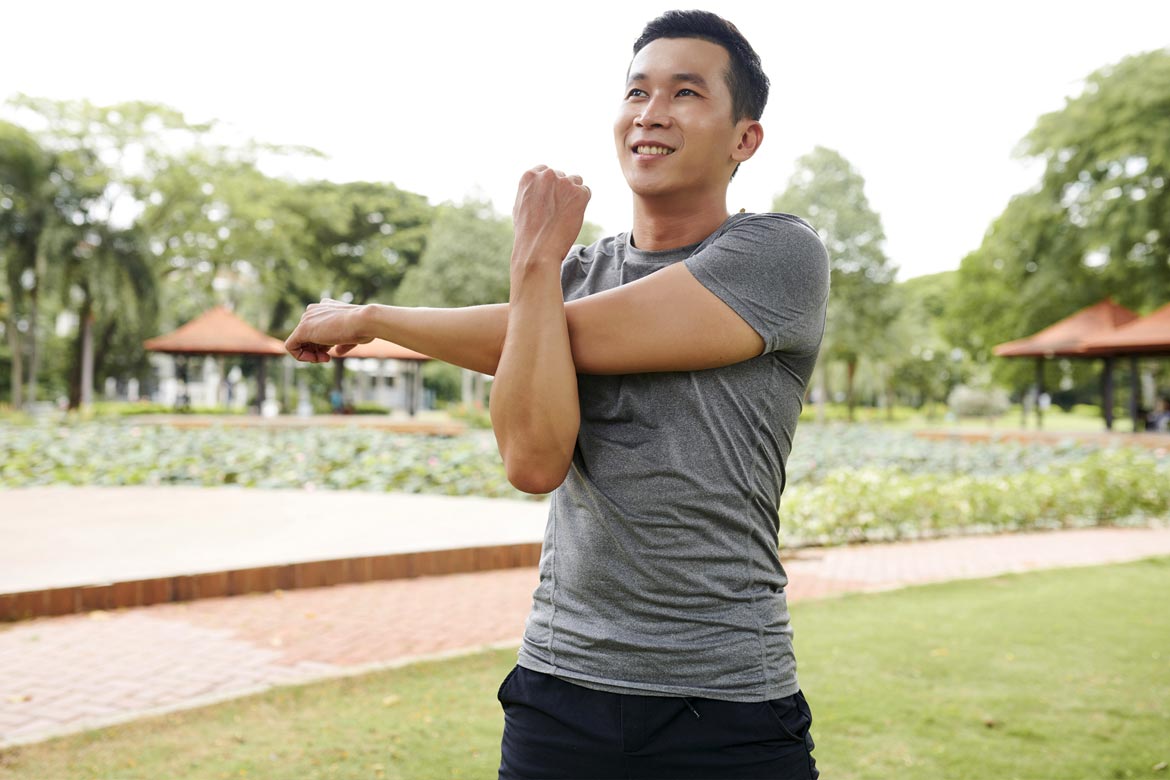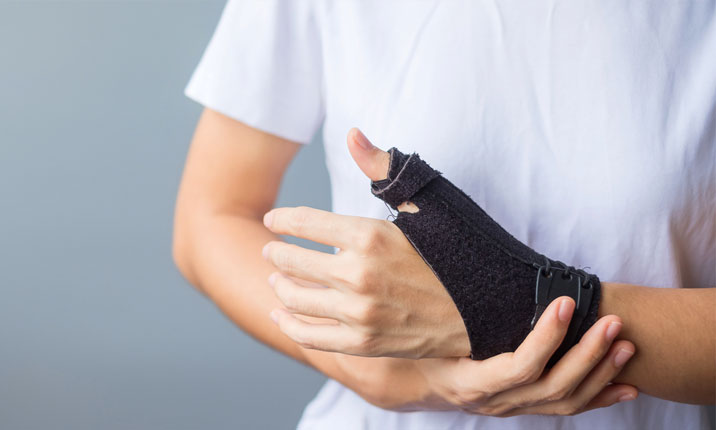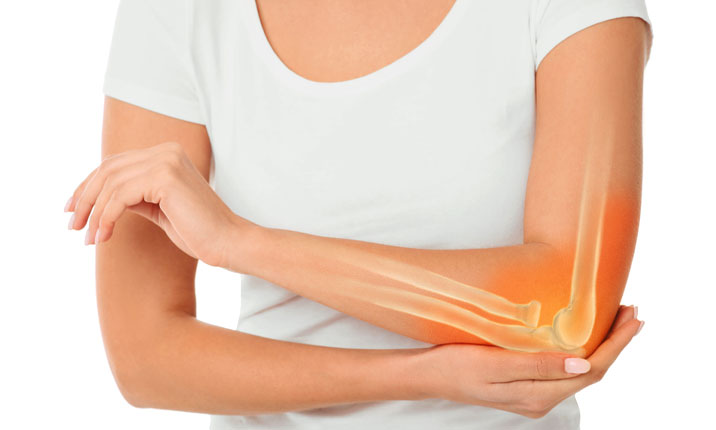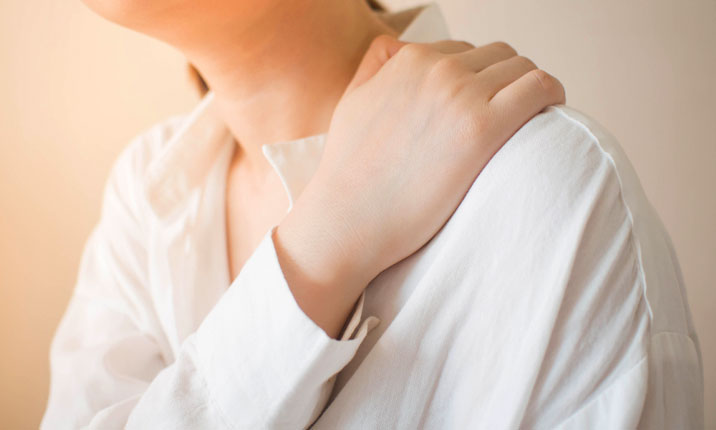
Common Upper Body Joint Conditions | Health Plus
14 Apr 2022
In this second instalment of our 2-part series, we zoom in on common upper body joint conditions that affect the wrist, arm and shoulder.
Did you know that sprains, strains and other bodily pains are among the many musculoskeletal conditions that doctors see in their clinics? When it comes to the upper body, musculoskeletal problems and injuries typically involve the wrist, elbow, or shoulder joints.
Let’s take a look at 3 of these common upper body conditions and their causes, symptoms, and available treatments.
Tendinitis of the Wrist (De Quervain’s Tenosynovitis)

De Quervain’s tenosynovitis is a common condition of the wrist caused by inflammation of the tendons involved in thumb movement. This inflammation and swelling of the tendon usually stems from repeated overuse of the wrist, such as prolonged hours gaming in front of a computer. This can also cause swelling in the tendon sheaths, resulting in pain and restricted movement as the tendons in our wrists are unable to move smoothly.
Signs and symptoms
Pain will be experienced over the side of the wrist near to the thumb, which worsens with movements such as gripping and bending of the wrist. De Quervain’s tenosynovitis is also called "mommy wrist" or “mommy thumb”, as it is very common in new mothers who have to hold and lift their growing babies.
Risk factors
The condition is also commonly seen in middle-aged women, as well as those who engage in activities that involve repetitive hand and wrist motions. These include gaming, gardening or racquet sports. Pregnant women, new mothers, as well as those with rheumatoid arthritis are also susceptible to developing de Quervain’s tenosynovitis.
Treatment
There are various treatment methods that can help alleviate this condition:
- Rest and activity modification
Avoiding the aggravating activity, and allowing the tendon and thumb to rest, can help reduce the inflammation. - Medication
Painkillers such as paracetamol or non-steroidal anti-inflammatory drugs (NSAIDs) such as ibuprofen may help to relieve the pain. - Wrist splints or wrist taping
Using wrist splints or tape to support the wrist and reduce wrist and thumb movement can allow the inflammation of the tendon to subside. - Injections
If the above measures do not improve the condition, corticosteroid injections may be used to reduce inflammation. - Surgery
If the condition fails to improve with conservative treatments, surgery may be recommended to open or expand the tendon sheath to reduce pressure on the inflamed tendons.
Tennis Elbow or Golfer’s Elbow (Tendinitis of the Elbow)

Both tennis elbow and golfer’s elbow consist of inflammation around the elbow joint which causes pain. The difference between tennis elbow and golfer’s elbow lies in the location where pain is experienced. In the former, pain is felt on the outer portion of the elbow; whereas in golfer’s elbow, the pain occurs on the inner side of the elbow. Both conditions are likely caused by overuse of the elbow joint or as a result of previous elbow injury.
Signs and symptoms
In tendinitis of the elbow, pain and tenderness is often experienced in the elbow joint itself. It may also be felt in your forearm and wrist. The pain can be worsened with certain movements, such as bending of the wrist and holding onto objects.
Risk factors
Those who engage in activities that involve repetitive motions of the wrist and arm are more likely to develop tennis and golfer’s elbows. This includes golfers, people who play racquet sports and even homemakers who chop and peel often while cooking. The condition may also affect individuals involved in manual work such as plumbing, painting and repairing cars.
Treatment
There are various treatment options for tendinitis of the elbow, including some that can be done at home.
- Rest and activity modification
Reduce activities that aggravate the elbow condition. - Medication
Your doctor may prescribe a short course of painkillers or anti-inflammatory medications to reduce pain and inflammation. - Physical therapy
Your doctor may refer you for physical therapy, which involves strengthening and stretching exercises for your forearm. - Brace
Your doctor may also prescribe an elbow or forearm brace to help relieve the symptoms by supporting the inflamed tendons in the elbow. - Injections
If your symptoms fail to improve after 6 – 8 weeks of home treatment, the doctor may recommend a corticosteroid injection to help reduce inflammation. In some cases, the recovery time may be longer, taking at least 6 – 12 months to heal. - Surgery
Should your symptoms still not improve after conservative treatment, surgery may be recommended.
Frozen Shoulder

Frozen shoulder occurs when the tissue surrounding your shoulder joint stiffens to the point that the tightness restricts and even inhibits shoulder movement.
Signs and symptoms
Typical symptoms of a frozen shoulder include pain, accompanied by stiffness and aches that may worsen at night. The range of movement of the affected shoulder may also be reduced. Generally, a frozen shoulder undergoes three phases:
- Freezing stage: Severe pain in the shoulder that gets worse over time and hurts more at night, with restricted shoulder movement.
- Frozen stage: Pain may be reduced but stiffness gets worse, making it difficult for the individual to conduct daily activities.
- Thawing stage: Shoulder movement begins to improve and return to normal.
Risk factors
Frozen shoulder is associated with conditions such as diabetes, thyroid conditions (hyperthyroidism and hypothyroidism), Parkinson's disease and previous shoulder injuries. The condition is also more common in women than men, and in middle-aged individuals between the ages of 40 – 60.
Treatment
- Medication
Common medications prescribed for a frozen shoulder include NSAIDs to reduce the symptoms and inflammation. - Physical therapy
NSAIDs combined with physical therapy are proven to be more effective than just medication alone. Physical therapy includes stretching exercises to maintain the range of movement and help control the pain. - Injections
If symptoms persist, a corticosteroid injection into the shoulder may be given to help reduce the symptoms. - Surgery
Should symptoms persist despite the above measures, surgery may be recommended to improve the condition.
Article contributed by Dr Wong Pei Ying, family physician at Parkway Shenton's in-house corporate clinic
References
Chan, Y., Pua, P. Y., & How, C. H. (2017). Physical therapy in the management of frozen shoulder. Singapore Medical Journal, 58(12), 685–689. Retrieved on 22-2-2022 from https://doi.org/10.11622/smedj.2017107
Chesterton, L. S., Mallen, C. D., & Hay, E. M. (2011). Management of tennis elbow. Open Access Journal of Sports Medicine, 2, 53–59. Retrieved on 22-2-2022 from https://doi.org/10.2147/OAJSM.S10310
De Quervain's Tendinosis. OrthoInfo. (2013, December). Retrieved October 5, 2021, from https://orthoinfo.aaos.org/en/diseases--conditions/de-quervains-tendinosis/.
Goel, R., & Abzug, J. M. (2015). De Quervain's Tenosynovitis: A review of the rehabilitative options. HAND, 10(1), 1–5. Retrieved on 22-2-2022 from https://doi.org/10.1007/s11552-014-9649-3
Informed Health Online. (2018, May 30). Golfer's elbow: Overview. NCBI. Retrieved October 5, 2021, from https://www.ncbi.nlm.nih.gov/books/NBK507002/.
Johnson, G. W., Cadwallader, K., Scheffel, S. B., & Epperly, T. D. (2007). Treatment of lateral epicondylitis. American Family Physician, 76(6), 843–848. Retrieved October 5, 2021, from https://www.aafp.org/afp/2007/0915/p843.html
Mayo Foundation for Medical Education and Research. (2020, August 1). Frozen shoulder. Mayo Clinic. Retrieved October 5, 2021, from https://www.mayoclinic.org/diseases-conditions/frozen-shoulder/symptoms-causes/syc-20372684.
Mayo Foundation for Medical Education and Research. (2020, July 23). De Quervain's tenosynovitis. Mayo Clinic. Retrieved October 5, 2021, from https://www.mayoclinic.org/diseases-conditions/de-quervains-tenosynovitis/diagnosis-treatment/drc-20371337.
Mayo Foundation for Medical Education and Research. (2020, October 10). Golfer's elbow. Mayo Clinic. Retrieved October 5, 2021, from https://www.mayoclinic.org/diseases-conditions/golfers-elbow/symptoms-causes/syc-20372868.
Mayo Foundation for Medical Education and Research. (2021, February 25). Tennis elbow. Mayo Clinic. Retrieved October 5, 2021, from https://www.mayoclinic.org/diseases-conditions/tennis-elbow/symptoms-causes/syc-20351987.
University of Michigan Health. (2020, November 16). Tennis elbow. Michigan Medicine. Retrieved October 5, 2021, from https://www.uofmhealth.org/health-library/hw225372.
Wheeler, T. (2021, March 18). What Is a Frozen Shoulder? WebMD. Retrieved October 5, 2021, from https://www.webmd.com/a-to-z-guides/what-is-a-frozen-shoulder.
Zelman, D. (2020, March 6). What’s de Quervain's Tenosynovitis? WebMD. Retrieved October 5, 2021, from https://www.webmd.com/rheumatoid-arthritis/guide/de-quervains-disease.




